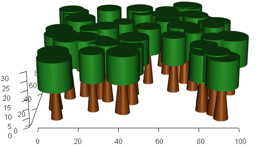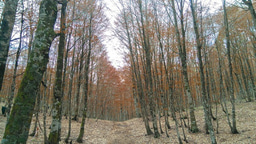Mycorrhizal Interactions and Environmental Gradients Shape Global Tree Species Richness
Published in Earth & Environment, Ecology & Evolution, and Plant Science

Forests are the most biomass-rich terrestrial ecosystems and play a crucial role in climate regulation and biodiversity conservation. However, human-induced disturbances threaten tree species with extinction and have caused widespread forest degradation. Understanding the mechanisms that maintain tree species diversity is essential for preserving forest ecosystems. While factors like climate, soil fertility, and negative density dependence have traditionally been emphasized, the influence of mutualistic interactions—especially mycorrhizal associations—has received less attention.
Mycorrhizal symbioses are among the most prevalent mutualistic relationships in forests. In these associations, fungi enhance nutrient uptake and protect plants against pathogens in exchange for carbon. Two primary types of mycorrhizal fungi are recognized: arbuscular mycorrhizal (AM) fungi and ectomycorrhizal (EcM) fungi. These differ in their functionality, specificity, and ecological roles, which can influence tree diversity in contrasting ways.
The EcM dominance hypothesis suggests that EcM fungi reduce negative plant-soil feedbacks more effectively than AM fungi, weakening negative density dependence and thus lowering species richness. Conversely, the mycorrhizal mixture hypothesis argues that communities with a balance of AM and EcM species exhibit greater niche partitioning, promoting coexistence and higher diversity. These differences in nutrient acquisition strategies and plant functional traits between AM and EcM species support the idea that mixed-mycorrhizal forests should be more diverse. An integrated hypothesis has also emerged, proposing an asymmetrical unimodal relationship where diversity peaks in mixed communities but is lower in EcM- than in AM-dominated forests.
Despite long-standing theoretical predictions, few empirical studies have evaluated these hypotheses globally. Recent studies have shown inconsistent patterns: some support the EcM dominance hypothesis, others point to a unimodal relationship between EcM dominance and species richness, thus favoring the mycorrhizal mixture hypothesis. To resolve these discrepancies, Jiang et al.'s study, recently published in Science Advances, analyzed a global dataset of over 440,000 forest plots, assessing the relationship between EcM tree proportion and species richness across latitude and aridity gradients.
Initial results using a downsampled dataset of 4,090 plots revealed that forests dominated by AM trees showed a wide range of species richness, while those dominated by EcM trees consistently exhibited low richness. A generalized linear model revealed that the relationship between EcM tree proportion and species richness changed with environmental gradients. Specifically, this relationship was negative in tropical forests, unimodal in boreal regions, and varied in temperate areas. Jiang et al.'s findings align with the integrated hypothesis and indicate that the influence of mycorrhizal type on diversity depends on climate.
Further analyses using random forest models confirmed that EcM tree proportion was a stronger predictor of species richness than most soil or topographic variables, though weaker than climate variables like temperature and aridity. The importance of EcM proportion increased from tropical to boreal forests, supporting the idea that mutualistic interactions matter more in certain biomes. Structural equation modeling revealed that climate and soil properties influenced tree species richness both directly and indirectly via their effect on EcM dominance. For instance, temperature had a strong indirect effect on richness through its impact on EcM tree proportion, especially in boreal forests.
Jiang et al.'s results offer nuanced support for the three hypotheses. In tropical forests, where biotic interactions such as herbivory and pathogen pressure are stronger, EcM trees benefit more from mycorrhizal protection and positive plant-soil feedbacks. These conditions foster EcM dominance and, due to the limited species pool of EcM trees in the tropics, result in lower species richness—supporting the EcM dominance hypothesis.
At mid-latitudes and under intermediate aridity, the integrated hypothesis best explains the data. Here, neither EcM nor AM species fully dominate, allowing both the suppression of negative feedbacks (by EcM fungi) and enhanced niche partitioning (from functional trait differences) to co-occur. This results in peak species richness in forests with a mixed mycorrhizal composition and a negatively unimodal relationship between EcM dominance and species richness.
In boreal and arid forests, environmental stress reduces the intensity of negative biotic interactions, such as competition and plant-soil feedbacks. Instead, positive interactions and niche differentiation may become more important. Under these conditions, both AM and EcM tree-dominated communities show lower species richness, but communities with mixed mycorrhizal types exhibit higher diversity, supporting the mycorrhizal mixture hypothesis.
Importantly, Jiang et al.'s study argues that these hypotheses are not mutually exclusive. Instead, their relative importance varies along environmental gradients. At low latitudes and in moist conditions, EcM fungi’s capacity to mitigate negative feedbacks leads to lower species richness. At higher latitudes or in dry environments, where environmental constraints reduce competition and feedback strength, the diversity-promoting effect of mixed mycorrhizal types becomes more significant.
Another factor contributing to lower richness in EcM-dominated tropical forests may be the smaller available species pool of EcM trees in these regions. However, the dominance of EcM trees in such settings is likely driven more by local processes—especially positive plant-soil feedbacks—than by climate or soil properties.
Overall, Jiang et al.'s study suggests that the global relationship between mycorrhizal type and tree species richness is complex and context-dependent. Environmental gradients modulate how mutualistic interactions affect diversity, and different mechanisms dominate under different ecological conditions. This work emphasizes the need for integrating biotic interactions, mycorrhizal ecology, and environmental context in forest biodiversity research and conservation planning.
In conclusion, mycorrhizal associations significantly shape global forest tree diversity, but their effects are modulated by latitude and aridity. The EcM dominance, mycorrhizal mixture, and integrated hypotheses each describe valid mechanisms that apply under different environmental circumstances. This global-scale study reconciles prior conflicting findings and highlights the multifaceted role of mutualisms in maintaining biodiversity across the world's forests.





Please sign in or register for FREE
If you are a registered user on Research Communities by Springer Nature, please sign in